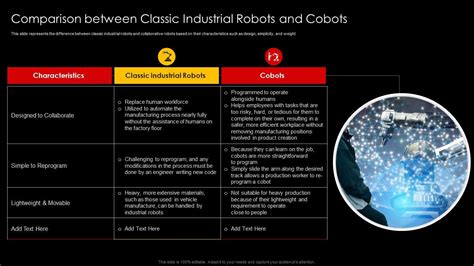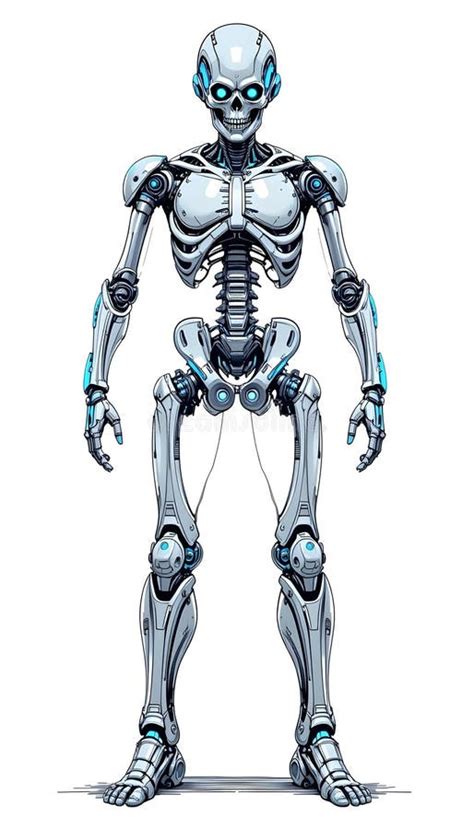The Symphony of Components: Unlocking the Potential of Industrial Robots
Industrial robots, the epitome of automation and efficiency, are composed of a harmonious array of components that orchestrate complex tasks with precision and speed. From the robust mechanical structure to the advanced sensors and controllers, each component plays a vital role in defining the robot's capabilities. Understanding these components is crucial for optimizing performance, minimizing downtime, and unlocking the full potential of these indispensable machines.
1. Mechanical Structure: The Robot's Skeletal Framework
The mechanical structure forms the skeleton of an industrial robot, providing support, stability, and mobility. It consists of a series of rigid links connected by joints, allowing for a wide range of motion and configurations. The structural design determines the robot's size, weight, reach, and payload capacity. For example, a robot intended for heavy-duty welding operations may have a more robust structure with thicker links and larger joints, while a robot designed for delicate assembly tasks may have a lighter, more agile structure.
Key Features of Mechanical Structure:
-
Links: The rigid parts that form the main structure of the robot.
-
Joints: The connections between links that allow for movement.
-
Payload Capacity: The maximum weight the robot can lift.
-
Reach: The maximum distance the robot's end-effector can extend from its base.
Considerations for Mechanical Structure:
- The material used for links and joints (e.g., aluminum, steel) affects the robot's weight, strength, and durability.
- The design of joints influences the robot's range of motion, accuracy, and speed.
- The overall structure should be optimized for the robot's intended application.
2. Actuators: The Muscles of the Robot
Actuators are the powerhouses that drive the robot's movement. They convert electrical energy into mechanical energy, causing the joints to rotate or extend. There are several types of actuators used in industrial robots, including electric motors, hydraulic cylinders, and pneumatic cylinders.

Key Features of Actuators:
-
Type: The mechanism used to generate force (e.g., electric, hydraulic, pneumatic).
-
Torque: The amount of force the actuator can generate.
-
Speed: The rate at which the actuator can move.
-
Precision: The accuracy with which the actuator can control motion.
Considerations for Actuators:
- The type of actuator selected depends on the required torque, speed, and precision.
- Electric motors are often preferred for their high efficiency and reliability.
- Hydraulic and pneumatic actuators offer high power and speed but may require more maintenance.
3. Sensors: The Robot's "Eyes" and "Ears"
Sensors provide the robot with information about its environment and its own state. They detect various physical parameters, such as position, force, velocity, and proximity. This data is essential for accurate and safe operation. Common sensors used in industrial robots include position sensors (e.g., encoders), force sensors, and vision systems.
Key Features of Sensors:
-
Type: The physical parameter the sensor measures (e.g., position, force, proximity).
-
Accuracy: The accuracy with which the sensor measures the parameter.
-
Resolution: The smallest change in the parameter that the sensor can detect.
-
Response Time: The time it takes for the sensor to respond to changes in the parameter.
Considerations for Sensors:
- The type and number of sensors required depend on the specific application and safety requirements.
- Sensor accuracy and resolution are critical for precise control and positioning.
- Sensor response time affects the robot's overall performance and safety.
4. Controllers: The Robot's Brain
Controllers are the "brains" of industrial robots, responsible for interpreting sensor data, making decisions, and commanding the actuators. They comprise hardware and software components that execute control algorithms to ensure accurate and efficient operation. There are various types of controllers used in industrial robots, including programmable logic controllers (PLCs), motion controllers, and robot controllers.
Key Features of Controllers:
-
Type: The specific hardware and software used to control the robot.
-
Processing Power: The speed and computational capacity of the controller.
-
Memory: The amount of memory available for storing programs and data.
-
I/O Ports: The number and type of input and output ports for connecting to sensors and actuators.
Considerations for Controllers:
- The type of controller selected depends on the robot's complexity and requirements.
- The processing power and memory capacity of the controller affect the robot's performance and capabilities.
- I/O ports enable the controller to communicate with other devices and systems.
5. End-Effectors: The Robot's "Hands"
End-effectors are the tools that attach to the robot's wrist and perform specific tasks, such as welding, gripping, or assembling. They come in various designs and configurations, customized to suit different applications. Common types of end-effectors include grippers, welding torches, and painting nozzles.

Key Features of End-Effectors:
-
Type: The specific tool or device used for the intended task.
-
Functionality: The specific action or operation the end-effector performs.
-
Capacity: The maximum weight or force the end-effector can handle.
-
Compatibility: The ability of the end-effector to attach to the robot's wrist.
Considerations for End-Effectors:
- The type of end-effector selected depends on the specific application and task requirements.
- The functionality and capacity of the end-effector determine its suitability for the intended operation.
- Compatibility ensures the end-effector can be securely attached to the robot's wrist.
6. Software: The Robot's Operating System
Software is the vital link between the robot's hardware and its intended functions. It encompasses various programs and algorithms that control the robot's movements, interpret sensor data, and enable communication with external systems. The software plays a crucial role in determining the robot's functionality, performance, and ease of use.
Key Features of Software:
-
Operating System: The core software platform that manages the robot's resources.
-
Control Algorithms: The mathematical models and algorithms used to control the robot's motion and behavior.
-
User Interface: The graphical or text-based interface through which operators interact with the robot.
-
Communication Protocols: The protocols used to communicate with sensors, actuators, and external systems.
Considerations for Software:
- The operating system and control algorithms determine the robot's fundamental capabilities and performance.
- The user interface should be intuitive and easy to use, even for non-technical operators.
- Communication protocols ensure seamless integration with other systems and devices.
7. Safety Features: Protecting Humans and Robots
Industrial robots operate in dynamic environments alongside human workers, making safety a paramount concern. Safety features are essential to minimize the risk of accidents and ensure the well-being of both humans and robots. These features include emergency stop buttons, safety fences, and collision detection systems.

Key Safety Features:
-
Emergency Stop Button: A large, easily accessible button that immediately stops the robot's motion in case of an emergency.
-
Safety Fences: Physical barriers that prevent humans from entering the robot's workspace while it is in operation.
-
Collision Detection Systems: Sensors that detect obstacles or potential collisions and trigger the robot to slow down or stop.
Considerations for Safety Features:
- Safety features should comply with industry standards and regulations.
- Emergency stop buttons must be strategically placed for easy access in any situation.
- Safety fences should be designed to prevent unauthorized access while allowing visibility of the robot's workspace.
- Collision detection systems should be reliable and have a fast response time.
8. Maintenance and Servicing: Ensuring Optimal Performance
Regular maintenance and servicing are crucial for maximizing the uptime and performance of industrial robots. These activities include routine inspections, lubrication, software updates, and preventative maintenance. By adhering to recommended maintenance schedules, robot owners can minimize downtime, extend the robot's lifespan, and reduce the risk of costly repairs.
Importance of Maintenance and Servicing:
- Prevents breakdowns and costly repairs.
- Extends the robot's lifespan and improves reliability.
- Optimizes performance and efficiency.
- Ensures compliance with safety regulations.
Recommended Maintenance Schedule:
- Follow the manufacturer's recommendations for regular inspections, lubrication, and software updates.
- Schedule preventative maintenance tasks based on the robot's usage and operating environment.
- Keep a detailed maintenance log to track inspections, repairs, and parts replacements.
9. Applications of Industrial Robots: A World of Possibilities
Industrial robots are used in a vast array of applications across various industries, including manufacturing, automotive, electronics, and healthcare. Their versatility and adaptability make them ideal for automating repetitive, dangerous, or highly precise tasks. Some of the most common applications include:
-
Manufacturing: Welding, assembly, packaging, painting
-
Automotive: Vehicle assembly, component inspection, welding
-
Electronics: Printed circuit board assembly, component testing, soldering
-
Healthcare: Drug dispensing, surgical assistance, laboratory automation
Benefits of Industrial Robots:
-
Increased Productivity: Robots can work tirelessly, increasing production output and efficiency.
-
Reduced Labor Costs: Robots can replace human workers in repetitive or hazardous tasks, lowering labor costs.
-
Improved Product Quality: Robots can perform tasks with precision and consistency, reducing defects and improving product quality.
-
Enhanced Safety: Robots can be used in dangerous or hazardous environments, protecting human workers from potential injuries.
Considerations for Implementing Industrial
